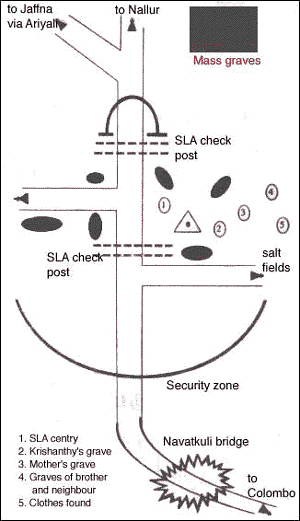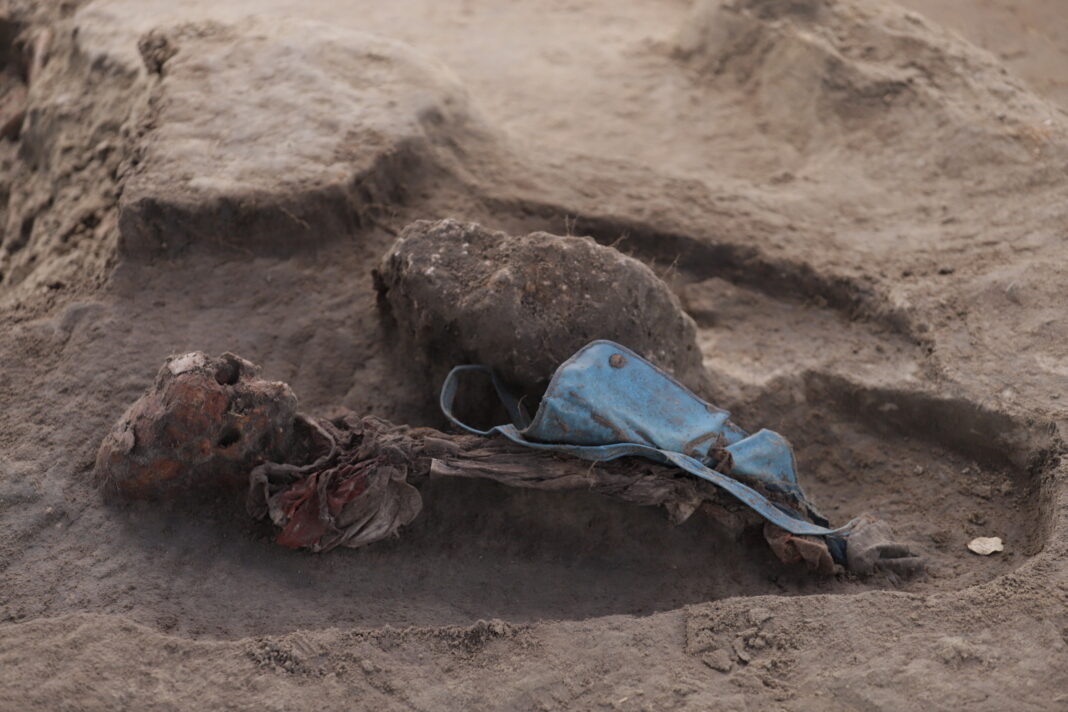Image: A child’s skeletal remains alongside a blue schoolbag and clothing items was unearthed at the (new) Chemmani mass grave site in Jaffna today, as the total number of human remains unearthed at the site now stands at 33.
Sunanda Deshapriya.
In July 1998, Yukthiya newspaper published an investigative article on the Chemmani mass grave. We spoke with a number of individuals, including a soldier who provided us with valuable information. I was the founding editor of Yukthiya weekly, which was supported by the Movement for Justice and Equality (MIRJE), a well-known peacebuilding organization. The investigation into the mass grave was carried out by Manoranjan.
In July 1998 the National Human Rights Commission urged the Sri Lankan Government to protect the areas of Chemmani where the bodies of between 300 and 400 people who disappeared whilst in military custody in Jaffna are alleged to have been buried. Meanwhile the government led by Chandrika Kumaratunga ordered the police to investigate the allegations.
In August 19908 issuing a press release, Amnesty asked the Attorney General “to ensure that the CID and HRC investigations were properly conducted” and “to ensure that the investigations of the site, including any exhumation, was impartially and independently conducted in such a way that any evidence collected was admissible in court”.
The exposure by Yukthiya newspaper resulted in excavations and the identification of some of the buried persons. Excavations started in February 1999. By September 1999 fourteen human skeletons had been dug up in the Chemmani area by investigators.
On 21 February evidence in the Chemmani mass graves case were displayed at the Jaffna Central College today for identification. The evidence was desplayed from 8 a.m. until 1 p.m. Nearly 200 people came to find if any of the unearthed objects belonged to relatives who have been reported ‘missing’.
Among these, a nose-stud and an undergarment were identified as belonging to Sumathy Sockalingam by her relatives. According to the relatives, she was abducted by the Sri Lanka Army soldiers from her home.
After Mahinda Rajapaksa became the president in 2005 the Chemmani mass grave investigation disappeared. By the time the files of the investigation were with the AG department.
In early 2025, construction work near the Chemmani–Sindhubathi Hindu cemetery unearthed human remains, prompting a court-ordered excavation. As of late June 2025, 33 human skeletons have been recovered, including those of three infants. The site has now been officially declared a mass grave by the Jaffna Magistrate’s Court.
The 1998 Yukthiya article was translated and published by TamilNet, which at the time was edited by Taraki, also known as Darmarathnam Sivaram.
Tamil Net article, 21 July 1998.
Between 300 and 400 of the 700 civilians who were reported missing soon after the Sri Lankan government forces took control of the Jaffna peninsula three years ago, are buried in the paddy fields surrounding the main road near Chemmani checkpoint said this week’s issue of Yukthiya, a Sinhala weekly. The paper has also published a map of the area, marking the location where the bodies are buried.
Yukthiya’s article follows revelations made by one of the accused in the ‘Krishanthy Kumaraswamy’ trial, about the existence of mass graves of civilians in the Jaffna peninsula.
These are translated extracts of the article:
When travelling to Jaffna from the south of the island, you will find a concrete structure built in an arch form, 3 km. from Jaffna town, on which it is written Jaffna welcomes you. Chemmani check posts are situated between this welcome board and Navatkuli bridge. There are no other buildings in the area, except the structures of check posts.
After the completion of ‘Operation Riviresa’ security personnel manning the Chemmani check posts received dead bodies with specific orders to bury them. They also received some living prisoners to be killed and buried the paper reports.
All these killings took place on the instructions of the senior commanding officers in Jaffna at that time reports the paper.
Krishanthy, her mother, brother and neighbour were killed by security personnel manning the checkpoint, the paper alleges. The soldiers committed these crimes with impunity trusting that their senior offices would not react, the paper goes on to say.
This incident brought widespread local and international condemnation which eventually led to the government taking legal against the involved security personnel. The six accused of the rape and murder of Krishanthy Kumaraswamy have now been sentenced to death.
Members of the present government took part in the excavation of the mass graves at “Sooriya Kanda” where Sinhalese youth murdered during the time of the previous government were buried.
“Yukthiya” journalists have launched an inquiry and were able to detect the places where these mass graves are located, along with a detailed diagram of their positions.
We feel that there is no need for secrecy this time since the present government has an International reputation for Human Rights.
According to our sources, these mass graves are quite close to the location where Krishanthy was buried after being repeatedly raped and in the map we published, we pinpointed where these graves are located, to make them easy to detect.

Soon after the “Riviresa Operation”, Jaffna was under the command of Brig. Sri Lal Weerasuriya, under whom two others Brigadiers, Janaka Perera and Karunatilake, were handling security in prescribed areas. The Chemmani area was under the command of Brig. Janaka Perera.
There is absolutely no way that so many civilians could have been killed and buried without the knowledge of these officers.
If an inquiry is ever launched in to this affair, the parts played by these officers should also be exposed to protect the true image of Human Rights in Sri Lanka.
Translation of extracts from the editorial:
While the government is basking in the glow of praises from all over the world for the manner in which they punished the killers of Krishanthy Kumaraswamy, it is facing another serious challenge over the revelation of mass graves in Jaffna, where most of those persons who disappeared after the army took over three years ago, are said to have been killed and buried.
The People’s Alliance leaders, who were so enthusiastically involved in digging up graves in Sooriya Kanda when they were in the opposition, must now take up this challenge or lose whatever image they have been able to develop as protectors of Human Rights.
They must not avoid this responsibility for fear of antagonising the Defence forces. It is also the responsibility of all human rights movements and lovers of democracy to push the government to do so.
Tamil Net
